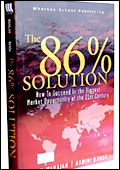 |
THE 86% SOLUTION
By Vijay Mahajan/ Kamini Banga
Pearson Power
PP: 224
Price: Rs 499 |
Developed
markets, which constitute 14 per cent of the world's population,
are not growing because these are more than saturated and are
also ageing fast. So, growth is going to come from hitherto unappealing
developing markets. These markets house 86 per cent of the world's
total population with a per capita gross national product of less
than $10,000 and per capita incomes of around $300. These markets
represent the future of global commerce and can solve one of the
most pressing problems of today's marketers, namely sustaining
growth. This is the gist of the first part of the book The 86%
Solution, co-authored by Vijay Mahajan, who holds the John P.
Harbin Centennial Chair in Business at McCombs School of Business,
University of Texas, and Kamini Banga, an independent marketing
consultant.
All this is too familiar to hold one's interest.
That India and China, the fastest growing markets in the world,
are extremely intricate to crack is no revelation to any marketer
in today's time and date. Haven't Unilever and P&G already
explored these markets, made their mistakes and learnt the lessons?
Even niche marketers like Louis Vuitton, Chanel and Rolls Royce
have identified their consumers here and are in the process of
figuring out the ways and means to reach out to them. So saying
that "there is no Indian market. There is a market in Mumbai
or Chennai, or in their local neighbourhoods" is actually
stating the obvious.
The second part of the book is, however,
interesting. Here, the authors spell out the specific challenges
in these markets and then, talk about the 86% solution to these
challenges. Mahajan and Banga delve into each aspect of the business
life cycle, right from inception to product design, packaging,
pricing, distribution to communication and advise marketers, with
ample examples, on how they shouldn't build a car when they need
a bullock cart or how to connect brands to the markets or how
to grow big by thinking small and how to use expatriates to enter
a new market. The conclusion they reach is: Population equals
profits. "...Numbers are on the side of the developing world...the
companies that can develop the right solution to meet their needs
will find a rich source of growth...," the authors say.
The book will be insightful for those who
haven't yet woken up to the realities of the emerging markets
and who still need to figure out India and China on the world
map.
 |
BRAND HIJACK
By Alex Wipperfurth
Penguin Portfolio
PP: 280
Price: Rs 595 |
If stealth weren't
such an insidious word, Wipperfurth would probably have called
his book Stealth Marketing and not Brand Hijack. For, the subject
of his book is, as the subtitle says, "marketing without
marketing". To be sure, Brand Hijack is not really about
stealth marketing. Rather, it's about how marketers should, first,
create a brand that consumers would want to adopt as their own,
and then let them control its future. Wipperfurth's opening examples
are the brands (Napster, Dr. Martens and Pabst Blue Ribbon beer)
his own San Francisco-based consulting firm Plan B works with.
He describes how these three, very diverse, brands have willingly
become putty in the hands of their customers. Romantic as the
notion is, nothing really happens accidentally. What the consumers
see as a phenomenal "non-marketing" success (remember
the movie The Blair Witch Project?) is actually the result of
painstaking, and often expensive, marketing. Therefore, despite
its alluring title, the book is about how to engage the consumers;
get them interested in your brand as if it were theirs. Isn't
that every marketer's ultimate dream?
|





